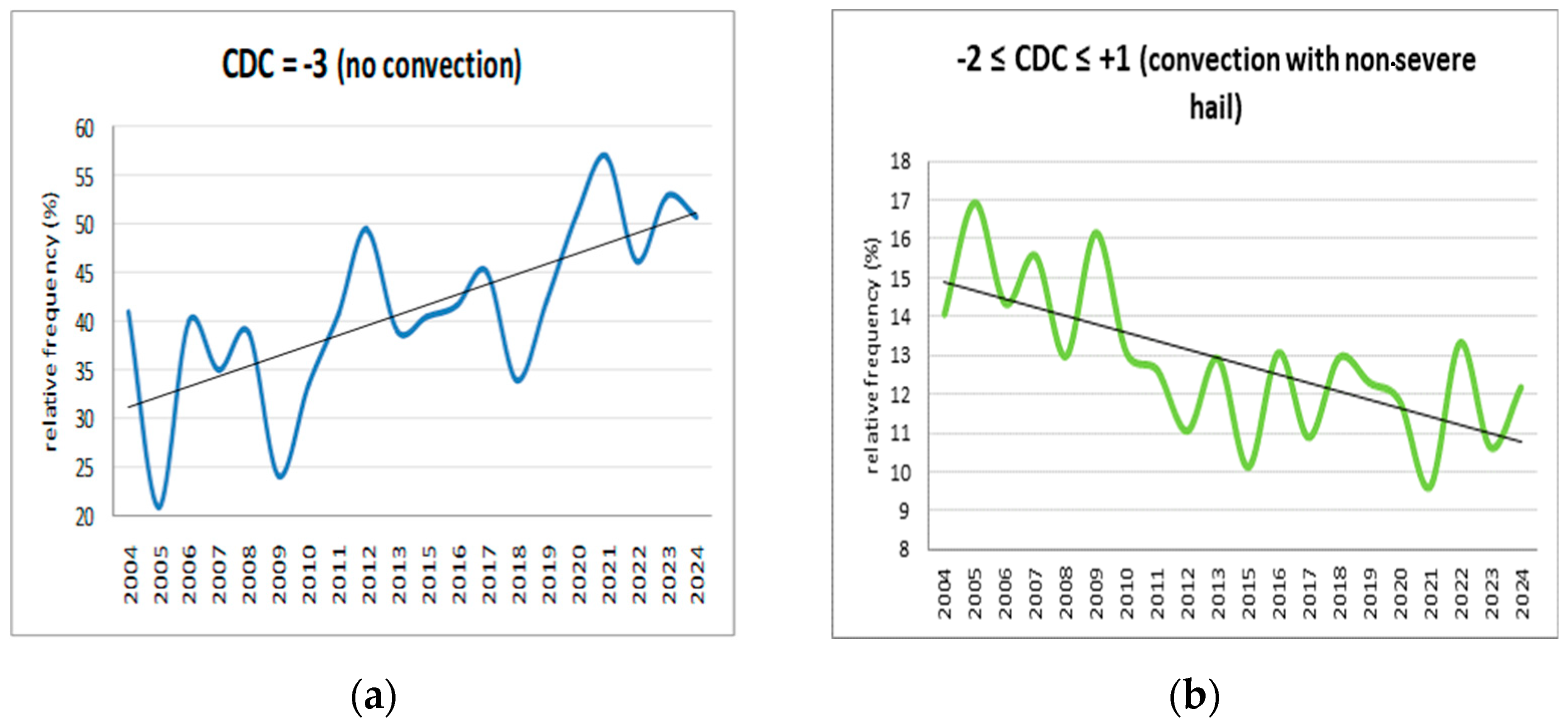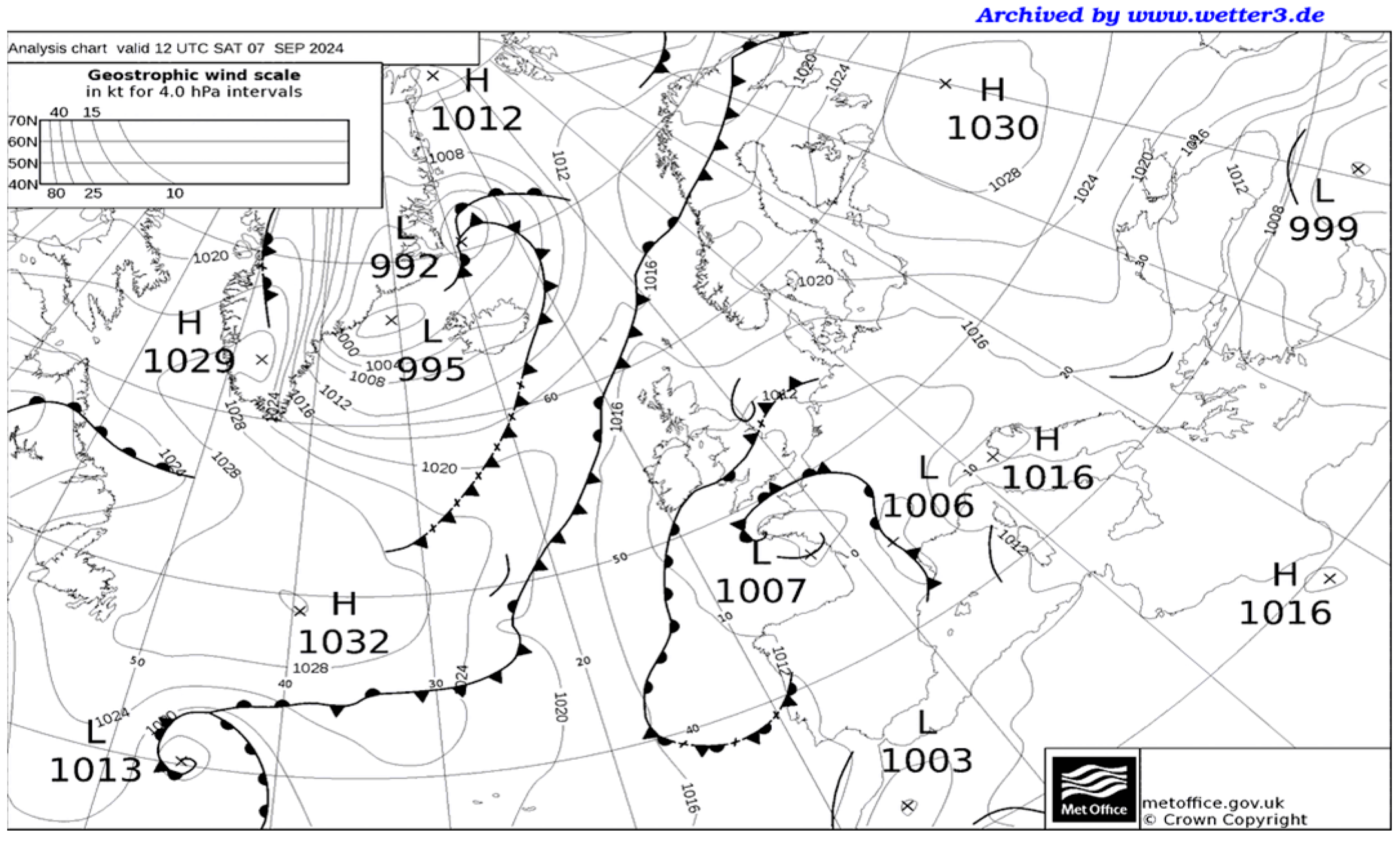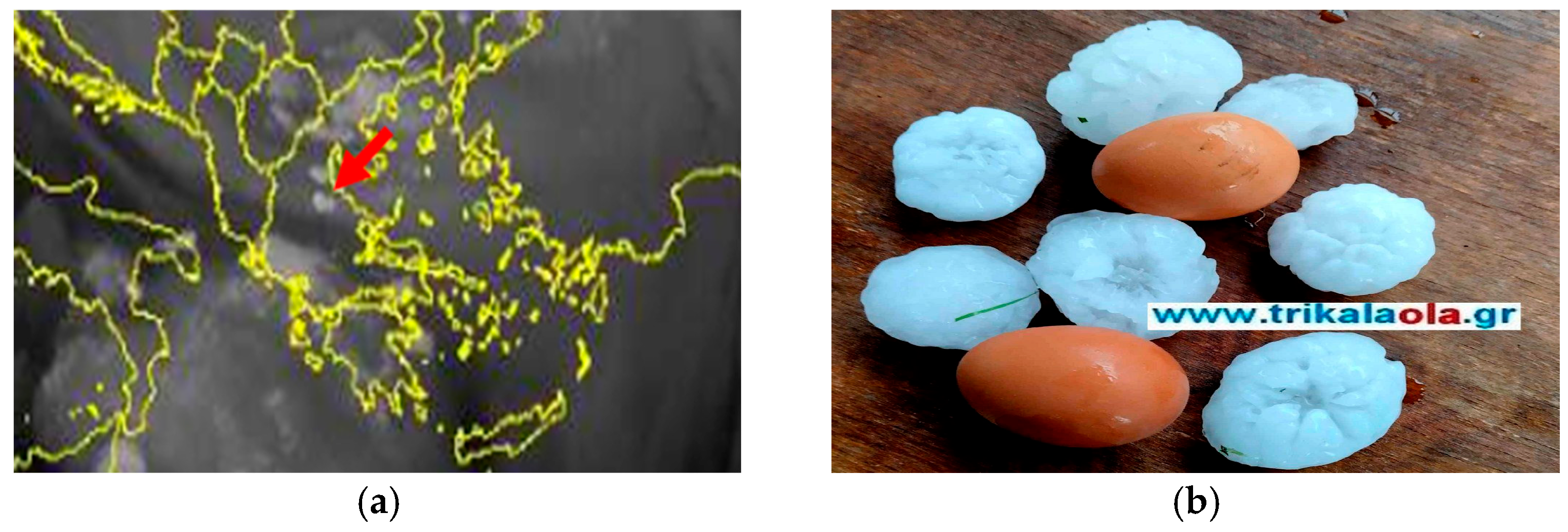Greek National Hail Suppression Program: Severe Supercell of CDC +4 Produces Egg-Sized Hail in Thessaly on 7 September 2024 †
Abstract
1. Introduction
2. Data and Methodology
3. The Classification of Convection by the Greek National Hail Suppression Program
4. CDC Extremes in Thessaly
5. The Case of 7 September 2024
6. Conclusions—Discussion
Author Contributions
Funding
Institutional Review Board Statement
Informed Consent Statement
Data Availability Statement
Acknowledgments
Conflicts of Interest
References
- Browning, K.A. Cellular structure of convective storms. Meteorol. Mag. 1962, 91, 341–350. [Google Scholar]
- Browning, K.A. The structure and mechanism of hailstorms. In Hail: A Review of Hail Science and Hail Suppression; American Meteorological Society: Boston, MA, USA, 1977; pp. 1–43. [Google Scholar]
- Marwitz, J.D. The structure and motion of severe hailstorms. Part 1: Supercell storms. J. Appl. Meteor. 1972, 11, 166–179. [Google Scholar] [CrossRef]
- Bunkers, M.J.; Hjelmfelt, M.R.; Smith, P.L. An observational examination of long-lived supercells. Part I: Characteristics, evolution and demise. Weather Forecast 2006, 21, 673–688. [Google Scholar] [CrossRef]
- Christodoulou, M.; Pytharoulis, I.; Karacostas, T. The July 10, 2019 Catastrophic Supercell over Northern Greece Part 1: Observational Analysis. In Proceedings of the 15th Panhellenic Conference of Meteorology, Climatology and Atmospheric Physics, Ioannina, Greece, 26–29 September 2021. [Google Scholar]
- Christodoulou, M.; Sioutas, M.; Tegoulias, I. Multiple Supercell Thunderstorms on 11 August 2021 Following an Extreme Heat Wave in Greece: An Unusual Event. In Proceedings of the 16th Panhellenic Conference of Meteorology, Climatology and Atmospheric Physics, Athens, Greece, 25–29 September 2023. [Google Scholar]
- Dixon, M.; Wiener, G. TITAN: Thunderstorm Identification, Tracking, Analysis and Nowcasting. A RADAR based Methodology. J. Atmos. Ocean. Technol. 1993, 10, 785–797. [Google Scholar] [CrossRef]
- Blumberg, W.G.; Halbert, K.T.; Supinie, T.A.; Marsh, P.T.; Hart, J.A. SHARPpy An open-source sounding analysis toolkit for the atmospheric sciences. Bull. Am. Meteor. Soc. 2017, 98, 1625–1636. [Google Scholar] [CrossRef]
- Karacostas, T.; Sioutas, M.; Rudolf, R. The Greek National Hail Suppression Program: Design and conduct of the experiment. In Proceedings of the 5th WMO Scientific Conference on Weather Modification and Applied Cloud Physics, Beijing, China, 8–12 May 1989. [Google Scholar]
- Vlachou, M.; Stolaki, S.; Sioutas, M. The Convective Day Category index and related synoptic, radar and hail parameters. In Proceedings of the 15th Panhellenic Conference of Meteorology, Climatology and Atmospheric Physics, Ioannina, Greece, 26–29 September 2021. [Google Scholar]
- Strong, G.S.; Wilson, W.D. The synoptic (instability) index: 1978–80 tests and new versions. In Proceedings of the 15th Annual Congress, Canadian Meteorological and Oceanographic Society, Saskatoon, Saskatchewan, 27–29 May 1981. [Google Scholar]
- Wetter3.de. Available online: https://www.wetter3.de/archiv_gfs_dt.html (accessed on 8 September 2024).
- Wetter3.de. Available online: https://www.wetter3.de/archiv_ukmet_dt.html (accessed on 8 September 2024).
- Van Den, S.C.; Cotton, W.R. The Impact of Hail Size on Simulated Supercell Storms. J. Atmos. Sci. 2002, 61, 1596–1609. [Google Scholar] [CrossRef]
- Wetterzentrale.de. Available online: https://www.wetterzentrale.de/reanalysis.php (accessed on 8 September 2024).
- Trikalaola.gr. Available online: https://www.trikalaola.gr/lachtarisan-sta-trikala-vomvardistikan-perioches-me-chalazi-megethous-avgon-vinteo-foto/ (accessed on 8 September 2024).






Disclaimer/Publisher’s Note: The statements, opinions and data contained in all publications are solely those of the individual author(s) and contributor(s) and not of MDPI and/or the editor(s). MDPI and/or the editor(s) disclaim responsibility for any injury to people or property resulting from any ideas, methods, instructions or products referred to in the content. |
© 2025 by the authors. Licensee MDPI, Basel, Switzerland. This article is an open access article distributed under the terms and conditions of the Creative Commons Attribution (CC BY) license (https://creativecommons.org/licenses/by/4.0/).
Share and Cite
Vlachou, M.; Brikas, D. Greek National Hail Suppression Program: Severe Supercell of CDC +4 Produces Egg-Sized Hail in Thessaly on 7 September 2024. Environ. Earth Sci. Proc. 2025, 35, 71. https://doi.org/10.3390/eesp2025035071
Vlachou M, Brikas D. Greek National Hail Suppression Program: Severe Supercell of CDC +4 Produces Egg-Sized Hail in Thessaly on 7 September 2024. Environmental and Earth Sciences Proceedings. 2025; 35(1):71. https://doi.org/10.3390/eesp2025035071
Chicago/Turabian StyleVlachou, Mary, and Dimitris Brikas. 2025. "Greek National Hail Suppression Program: Severe Supercell of CDC +4 Produces Egg-Sized Hail in Thessaly on 7 September 2024" Environmental and Earth Sciences Proceedings 35, no. 1: 71. https://doi.org/10.3390/eesp2025035071
APA StyleVlachou, M., & Brikas, D. (2025). Greek National Hail Suppression Program: Severe Supercell of CDC +4 Produces Egg-Sized Hail in Thessaly on 7 September 2024. Environmental and Earth Sciences Proceedings, 35(1), 71. https://doi.org/10.3390/eesp2025035071




